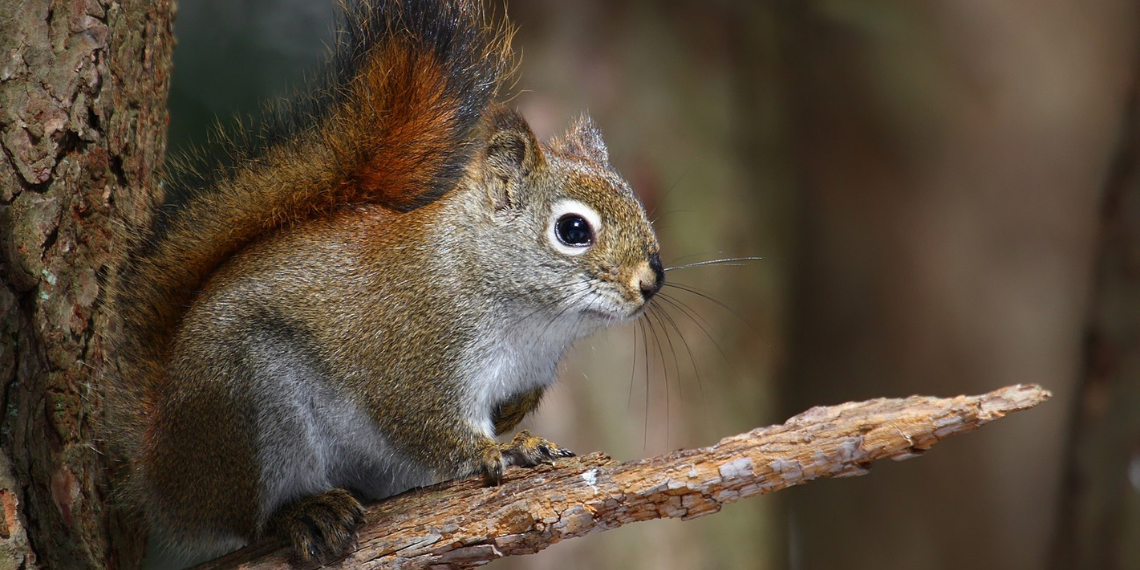Welcome to the Neighbourhood: Red Squirrel Neighbours Share Gut Microbiome

For the last 30 years, a population of squirrels in southwestern Yukon has been closely watched by biologists, though perhaps never more closely than a recent investigation into the microscopic contents of their guts.
A study published in Environmental Microbiology Reports details how both time and space can affect the composition of the squirrel microbiome. Spearheaded by then-Master’s student Alicia Halhed and supervised by Dr. Karl Cottenie, both from the Department of Integrative Biology, this project reveals some surprising insights into the invisible world of gut-dwelling microbes.
“We collaborated with the Kluane Red Squirrel Project, which has a unique dataset of over 900 samples of squirrel faeces, looking for signatures in their gut microbiomes,” says Cottenie.
The community of microbes that lives in the intestinal tracts of animals is collectively known as the gut microbiome. While research abounds on the microbiomes of humans and lab mice, studies in wild animals are still few and far between.
“Studying the microbiome in the wild is important because there are a lot of claims that microbiomes determine everything,” explains Cottenie. “Experimental manipulations on mice are akin to hitting you over the head with a hammer, which will of course influence behaviour. However, the relevance to what happens in nature is unclear.”
The Kluane Red Squirrel Project provides a unique opportunity to study the gut microbiome of wild mammals that are individually marked and continuously monitored. The tireless work of students and field assistants ensures that observations and samples are collected throughout the squirrels’ lives, including some of their droppings. This faecal sampling is opportunistic and non-invasive—ensuring that the squirrels can keep going about their squirrel lives.
Extracting the bacterial DNA in the squirrels’ droppings allows researchers to identify the microbial species present in their guts. The bacteria found in most samples, in relatively large quantities, make up what is called the “core” microbiome. A single squirrel’s microbiome signature—both core and non-core—can be compared over time, as well as to that of other squirrels in the population.
The team was surprised to discover how much squirrels’ microbiomes changed over time and space.
“Even in the core microbiome, which we expected to be more homogeneous, there was a lot more variation than we expected, including at the individual level,” says Cottenie. Some of this variation may be explained by changes in diet as the seasons change.
Yet, despite the high variation in microbiome composition, the researchers also found some surprising similarities in the microbiomes of neighbouring squirrels.
“We were surprised to see spatial patterns at a fine scale of less than one square kilometre,” explains Cottenie. “Neighbouring squirrels had a more similar microbiome than squirrels that lived far apart.”
To survive the harsh Yukon winters, red squirrels hoard food. Every squirrel fiercely defends its territory—the area centred around its main food cache. But that doesn’t mean that these caches aren’t vulnerable to the occasional thievery by other squirrels.
The fact that neighbouring squirrels try to pilfer each other’s stores—which can lead to indirect transmission of gut microbes—might play a role in making the gut microbiomes of neighbours more similar to each other.
“It might be that neighbours exchange their gut microbes,” says Cottenie.
Identifying the microbes present in the squirrels’ guts is just the tip of the iceberg for the Kluane Red Squirrel Project. Moving forward, Cottenie hopes to see individual squirrel data incorporated into microbiome research.
“Since all squirrels are individually marked, future studies could involve the identity of each squirrel, their interactions and territorial fights, as well as who they’re stealing food from,” says Cottenie. “Transplant experiments, where squirrels are swapped between territories, could also help determine causal links.”
The next 30 years of the Kluane Red Squirrel Project will, undoubtedly, have many more surprising revelations for those observing and recording these charming mammals.
This study was funded by the Natural Sciences and Engineering Research Council of Canada and the Shared Hierarchical Academic Research Computing Network (Compute Canada).
Read the full study in the journal Environmental Microbiology Reports.
Read about other CBS Research Highlights.